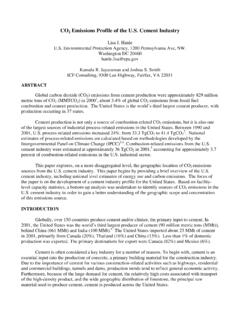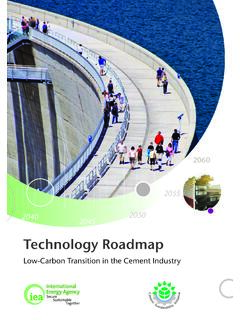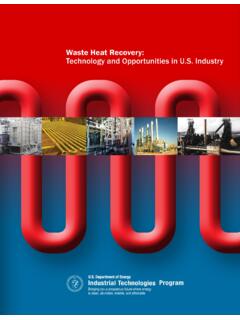Transcription of A Review On Environmental and Health Impacts Of Cement ...
1 International Journal of Geology, Agriculture and Environmental Sciences Volume 2 Issue 3 June 2014 Website: ISSN: 2348-0254 WOAR Journals Page 26 A Review On Environmental and Health Impacts Of Cement Manufacturing Emissions Shraddha Mishra, Dr. Nehal Anwar Siddiqui Health , Safety & Environment, University of Petroleum & Energy Studies, Dehradun, Uttarakhand, India Abstract: Climate change is considered as major Environmental challenge for the world.
2 Emissions from Cement manufacturing are one of the major contributors in global warming and climate change. Cement manufacturing is a highly energy intensive process, which involves intensive fuel consumption for clinker making and resulting in emissions. Beside Fuel consumption, the calcining process is a major source of emissions such as NOx, SOx, CO2, particulate matters etc. In this paper, the role of Cement industry is reviewed in causing impact on environment and Health . It describes the Cement production process and its emission sources followed by overview of emissions and their Environmental and Health Impacts .
3 Review study has focused on emission generation from clinker production and excluded the emissions due to indirect energy (electricity, transportation, supply chain etc.) used for Cement operations. This Review observed a comprehensive literature in term of peer reviewed journals, industry sector reports, websites etc on Cement industry and associated emissions and Health Impacts . Keywords: Cement manufacturing, emissions, SO2, NOx, PMs, CO2, Environmental impact, Health Impacts , sustainability. 1. Introduction It is impossible to envisage a modern life without Cement .
4 Cement is an extremely important construction material used for housing and infrastructure development and a key to economic growth. Cement demand is directly associated to economic growth and many growing economies are striving for rapid infrastructure development which underlines the tremendous growth in Cement production [1]. The Cement industry plays a major role in improving living standard all over the world by creating direct employment and providing multiple cascading economic benefits to associated industries.
5 Despite its popularity and profitability, the Cement industry faces many challenges due to Environmental concerns and sustainability issues [2]. The Cement industry is an energy intensive and significant contributor to climate change. The major environment Health and safety issues associated with Cement production are emissions to air and energy use. Cement manufacturing requires huge amount of non renewable resources like raw material and fossil fuels. It is estimated that 5-6% of all carbon dioxide greenhouse gases generated by human activities originates from Cement production [2].
6 Raw material and Energy consumption result in emissions to air which include dust and gases. The exhaust gases from a Cement kiln contains are nitrogen oxides (NOx), carbon dioxide, water, oxygen and small quantities of dust, chlorides, fluorides, sulfur dioxide, carbon monoxide , and still smaller quantities of organic compounds and heavy metals [3]. Toxic metals and organic compounds are released when industrial waste is burnt in Cement kiln. Other sources of dust emissions include the clinker cooler, crushers, grinders, and materials-handling equipment.
7 Figure 1: Global Cement Production 1970-2050 (Source: International Energy Agency (IEA) These emissions are not only deteriorating air quality but also degrading human Health . Emissions have local and global environment impact resulting in global warming, ozone depletion, acid rain, biodiversity loss, reduced crop productivity etc [4]. Scientific evidence indicates that air pollution from the combustion of fossil fuels causes a spectrum of Health effects from allergy to death [5]. The results of several studies showed that these emissions are adversely affecting human Health in a variety of ways, like itchy eyes, WOAR Journals Page 27 respiratory diseases like tuberculosis, chest discomfort, chronic bronchitis, asthma attacks, cardio-vascular diseases and even premature death [6], [7].)
8 2. Cement Manufacturing Process: The main component of Cement is clinker, which is produced from raw materials, such as limestone and clay. [8]. Limestone supplies CaCO3 for the Cement production. Silica, alumina, and iron are considered to be other raw materials. The lime stone used for Cement manufacturing contains 75-90 % of CaCo3 and remainder is MgCo3 and impurities [11]. Raw material is extracted through mining and quarrying which follows drilling, blasting, excavating, handling, loading, hauling, crushing, screening, stockpiling, and storing [10].
9 A specific composition of the raw materials are crushed and then milled into a raw meal for the quality and uniformity of Cement . This raw meal is blended in blending silos and is then heated in the pre-heating system. This process dissociates carbonate to calcium oxide and carbon dioxide [11]. It can be accomplished by any of three processes: the dry process, the wet process, or the semidry process [10]. In a dry Cement manufacturing process, dry raw mix contains less than 20% moisture by mass.
10 However, in a wet process water is added to the raw mix to form slurry and then is transported to the kiln [11]. Raw meal or blended raw materials are fed into the upper end of the pre-heater tower and then passed through the end of the rotary Kiln. A rotary kiln is a tube with a diameter up to about 6 m. which is installed at a horizontal angle of 3o 4o and rotates slowly with about one to four RPM [9]. The Kiln rotates and the ground raw material moves down toward the flame. As the temperature increases, the sequence of chemical and physical changes starts with reaction taking place between calcium oxide and other elements.








